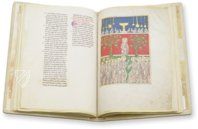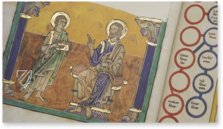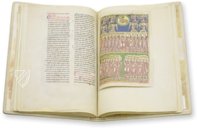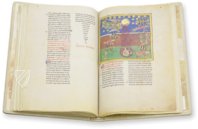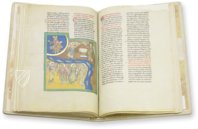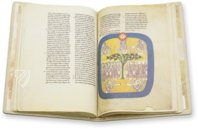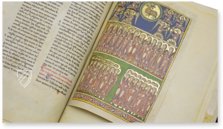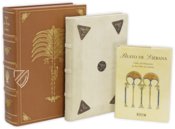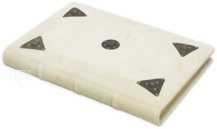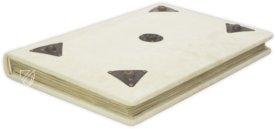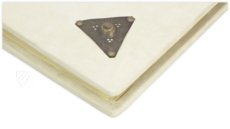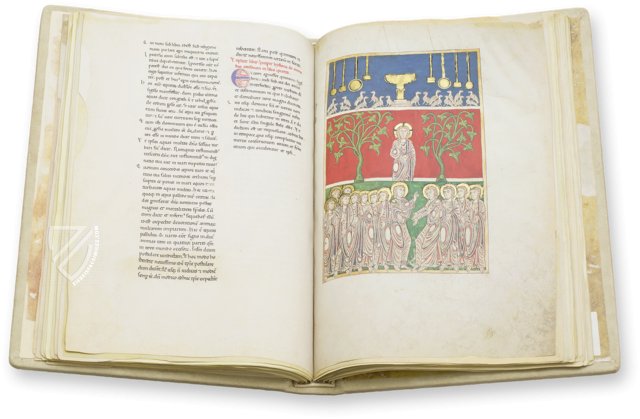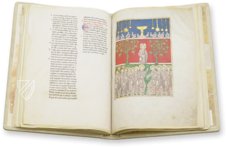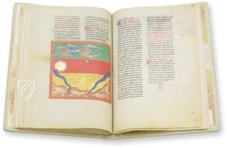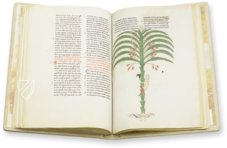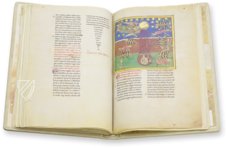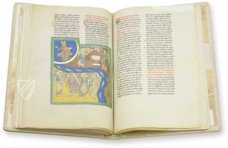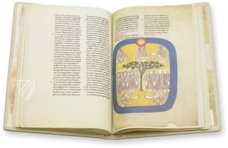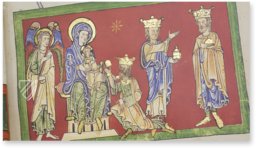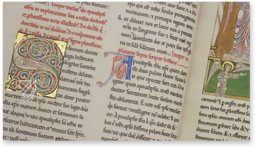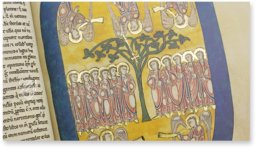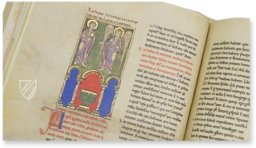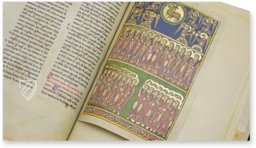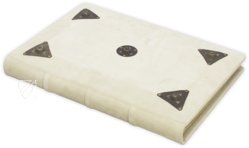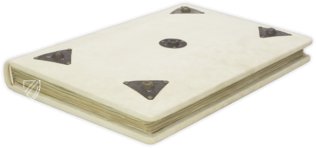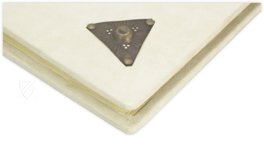Beatus of Liébana - San Pedro de Cardeña Codex
(3,000€ - 7,000€)
The San Pedro de Carden͂a Codex is one of the most magnificently illuminated manuscripts of the Beatus tradition. This codex was created around 1180 in the scriptorium of the monastery of San Pedro de Carden͂a in present-day Spain. The copy of the famous Apocalypse commentary by Beatus of Liébana (died after 798) contains 51 gold-decorated miniatures that combine different styles of book illumination in an interesting way. While one hand still adheres to late Romanesque art, the second already incorporates the highly innovative developments of the early Gothic period, which makes the manuscript a particularly exciting art-historical gem. The fascinating codex was divided several times in the course of its history. The individual fragments, which comprise a total of 145 surviving folios, are now held in four different museums in Spain and the USA, which makes the facsimile edition that brings them together all the more appealing.
Beatus of Liébana - San Pedro de Carden͂a Codex
The Book of Revelation, which is also known as the Apocalypse, is the last book of the New Testament. The story of the end of the world, of Judgement Day, of the sinners’ descent into hell, tremendously fascinated Christians from every land. A Spanish monk by the name of Beatus wrote a commentary on this book from the Bible, which was adapted over several centuries thereafter. One manuscript originating from the tradition of Beatus is the San Pedro de Carden͂a Codex. This codex originates from Spain ca. 1180 and is divided among collections in Madrid, New York, and Girona.
Who Was Beatus?
Beatus of Liébana was a monk and theologian, who belonged to the Monastery of Santo Toribio de Liébana in Spain. The monk is famous above all for his magnum opus, a commentary on the biblical Apocalypse in twelve books. These twelve books originate from ca. 776 and are known today as the Beatus-Series. The twelve books were adapted into countless manuscripts, many of which survive to this day. The majority of Beatus manuscripts originate from between the 10th and 12th centuries in northern Spain. The codex from 1180 originates from the scriptorium of the Monastery of San Pedro de Carden͂a and marks an interesting mix of styles during the transition from late-Romanesque to earl-Gothic illumination.
Historically Significant Miniatures
The San Pedro de Carden͂a Codex is illustrated with 51 highly-valuable miniatures, which are richly adorned with gold. Today it cannot be said for certain who was responsible for the valuable images. The miniatures of this Beatus manuscript are of particular historical appeal because they transcend the threshold from late-Romanesque to early-Gothic. Both tendencies can be clearly distinguished from one another in the codex, showing that two differently schooled painters of comparably high quality cooperated. The original edition of the codex only exists in individual fragments. Some pages of the manuscript are found today in the prestigious Metropolitan Museum in New York. The museums of Arqueológico Nacional and Colección Francisco de Zabálburu y Basabe in Madrid also possess some pages in their collection. Additional sections are housed in the Art Museum of Girona.
Codicology
- Alternative Titles
- Beato de Liébana, códice del Monasterio de San Pedro de Cardeña, Burgos
Cardeña Beatus
Beatus von Cardeña
Beato di Cardeña
Béatus de Cardeña - Size / Format
- 290 pages / 44.5 × 30.0 cm
- Origin
- Spain
- Date
- Between 1175 and 1185
- Epochs
- Style
- Genre
- Language
- Illustrations
- 51 gold-decorated miniatures
- Content
- Beatus Commentary on the Book of Revelation
- Artist / School
- Beatus of Liébana (died after 798) (author)
Beatus of Liébana - Burgo de Osma Codex
The First Trumpet
Immediately following the Seven Seals, angels assemble to blow the Seven Trumpets, each signifying a new disaster to befall the earth, referred to as “woes”. This series of calamities begins with an apocalyptic hailstorm, a downpour as destructive as a bombing raid. “The first angel sounded: And hail and fire followed, mingled with blood, and they were thrown to the earth. And a third of the trees were burned up, and all green grass was burned up.” (Rev. 8:7)

Beatus of Liébana - San Pedro de Cardena Codex
The Second Trumpet
The miniatures of this manuscript mark the transition to the Gothic style from the traditional Romanesque of Beatus manuscripts. Both styles are displayed side-by-side in the manuscript. The miniature at hand depicts the blowing of the Second Trumpet, which causes a great mountain burning with fire to be cast into the sea, turning a third of it into blood while also destroying a third of the fish and ships therein.
The figure of the angel suspended in a dark blue heaven has the lithe figure associated with the Gothic style, with natural folds in the garments and detailed wings of red, blue, and shimmering gold, which was also used for the halo and trumpet. The sea is divided into thirds by color, with the blood-third at the bottom filled with the victims of the catastrophe.

#1 Beato de Liébana, códice del Monasterio de San Pedro de Cardeña, Burgos
Language: Spanish
(3,000€ - 7,000€)
- Treatises / Secular Books
- Apocalypses / Beatus
- Astronomy / Astrology
- Bestiaries
- Bibles / Gospels
- Chronicles / History / Law
- Geography / Maps
- Saints' Lives
- Islam / Oriental
- Judaism / Hebrew
- Single Leaf Collections
- Leonardo da Vinci
- Literature / Poetry
- Liturgical Manuscripts
- Medicine / Botany / Alchemy
- Music
- Mythology / Prophecies
- Psalters
- Other Religious Books
- Games / Hunting
- Private Devotion Books
- Other Genres
- Afghanistan
- Armenia
- Austria
- Belgium
- Colombia
- Croatia
- Cyprus
- Czech Republic
- Denmark
- Egypt
- Ethiopia
- France
- Germany
- Greece
- Hungary
- India
- Iran
- Iraq
- Israel
- Italy
- Japan
- Lebanon
- Luxembourg
- Mexico
- Morocco
- Netherlands
- Palestine
- Peru
- Poland
- Portugal
- Russia
- Serbia
- Spain
- Sri Lanka
- Sweden
- Switzerland
- Syria
- Turkey
- Ukraine
- United Kingdom
- United States
- Uzbekistan
- Aboca Museum
- Ajuntament de Valencia
- Akademie Verlag
- Akademische Druck- u. Verlagsanstalt (ADEVA)
- Aldo Ausilio Editore - Bottega d’Erasmo
- Alecto Historical Editions
- Alkuin Verlag
- Almqvist & Wiksell
- Amilcare Pizzi
- Andreas & Andreas Verlagsbuchhandlung
- Archa 90
- Archiv Verlag
- Archivi Edizioni
- Arnold Verlag
- ARS
- Ars Magna
- ArtCodex
- AyN Ediciones
- Azimuth Editions
- Badenia Verlag
- Bärenreiter-Verlag
- Belser Verlag
- Belser Verlag / WK Wertkontor
- Benziger Verlag
- Bernardinum Wydawnictwo
- BiblioGemma
- Biblioteca Apostolica Vaticana (Vaticanstadt, Vaticanstadt)
- Bibliotheca Palatina Faksimile Verlag
- Bibliotheca Rara
- Boydell & Brewer
- Bramante Edizioni
- Bredius Genootschap
- Brepols Publishers
- British Library
- C. Weckesser
- Caixa Catalunya
- Canesi
- CAPSA, Ars Scriptoria
- Caratzas Brothers, Publishers
- Carus Verlag
- Casamassima Libri
- Chavane Verlag
- Christian Brandstätter Verlag
- Circulo Cientifico
- Club Bibliófilo Versol
- Club du Livre
- CM Editores
- Collegium Graphicum
- Collezione Apocrifa Da Vinci
- Comissão Nacional para as Comemorações dos Descobrimentos Portugueses
- Coron Verlag
- Corvina
- CTHS
- D. S. Brewer
- Damon
- De Agostini/UTET
- De Nederlandsche Boekhandel
- De Schutter
- Deuschle & Stemmle
- Deutscher Verlag für Kunstwissenschaft
- DIAMM
- Droz
- E. Schreiber Graphische Kunstanstalten
- Ediciones Boreal
- Ediciones Grial
- Ediclube
- Edições Inapa
- Edilan
- Editalia
- Edition Deuschle
- Edition Georg Popp
- Edition Leipzig
- Edition Libri Illustri
- Editiones Reales Sitios S. L.
- Éditions de l'Oiseau Lyre
- Editions Medicina Rara
- Editorial Casariego
- Editorial Mintzoa
- Editrice Antenore
- Editrice Velar
- Edizioni Edison
- Egeria, S.L.
- Eikon Editores
- Electa
- Emery Walker Limited
- Enciclopèdia Catalana
- Eos-Verlag
- Ephesus Publishing
- Ernst Battenberg
- Eugrammia Press
- Extraordinary Editions
- Fackelverlag
- Facsimila Art & Edition
- Facsimile Editions Ltd.
- Facsimilia Art & Edition Ebert KG
- Faksimile Verlag
- Feuermann Verlag
- Folger Shakespeare Library
- Franco Cosimo Panini Editore
- Friedrich Wittig Verlag
- Fundación Hullera Vasco-Leonesa
- G. Braziller
- Gabriele Mazzotta Editore
- Gebr. Mann Verlag
- Gesellschaft für graphische Industrie
- Getty Research Institute
- Giovanni Domenico de Rossi
- Giunti Editore
- Graffiti
- Grafica European Center of Fine Arts
- Guido Pressler
- Guillermo Blazquez
- Gustav Kiepenheuer
- H. N. Abrams
- Harrassowitz
- Helikon
- Hendrickson Publishers
- Henning Oppermann
- Herder Verlag
- Hes & De Graaf Publishers
- Hoepli
- Holbein-Verlag
- Hortus Deliciarum
- Houghton Library
- Hugo Schmidt Verlag
- Idion Verlag
- Il Bulino, edizioni d'arte
- ILte
- Imago
- Insel Verlag
- Instituto Nacional de Antropología e Historia
- Istituto dell'Enciclopedia Italiana - Treccani
- Istituto Ellenico di Studi Bizantini e Postbizantini
- Istituto Geografico De Agostini
- Istituto Poligrafico e Zecca dello Stato
- Italarte Art Establishments
- J. Thorbecke
- Jan Thorbecke Verlag
- Johnson Reprint Corporation
- Josef Stocker
- Josef Stocker-Schmid
- Jugoslavija
- Karl W. Hiersemann
- Kasper Straube
- Kaydeda Ediciones
- Kindler Verlag / Coron Verlag
- Kodansha International Ltd.
- Konrad Kölbl Verlag
- Kurt Wolff Verlag
- La Liberia dello Stato
- La Linea Editrice
- La Meta Editore
- Lambert Schneider
- Landeskreditbank Baden-Württemberg
- Leo S. Olschki
- Les Incunables
- Library of Congress
- Libreria Musicale Italiana
- Lichtdruck
- Lito Immagine Editore
- Lumen Artis
- Lund Humphries
- M. Moleiro Editor
- Maison des Sciences de l'homme et de la société de Poitiers
- Manuscriptum
- Martinus Nijhoff
- Maruzen-Yushodo Co. Ltd.
- MASA
- McGraw-Hill
- Militos
- Millennium Liber
- Müller & Schindler
- Nahar and Steimatzky
- National Library of Wales
- Neri Pozza
- Nova Charta
- Oceanum Verlag
- Odeon
- Orbis Mediaevalis
- Orbis Pictus
- Österreichische Staatsdruckerei
- Oxford University Press
- Pageant Books
- Parzellers Buchverlag
- Patrimonio Ediciones
- Pattloch Verlag
- PIAF
- Pieper Verlag
- Plon-Nourrit et cie
- Prestel Verlag
- Princeton University Press
- Prisma Verlag
- Priuli & Verlucca, editori
- Pro Sport Verlag
- Propyläen Verlag
- Pytheas Books
- Quaternio Verlag Luzern
- Reales Sitios
- Recht-Verlag
- Reichert Verlag
- Reichsdruckerei
- Riehn & Reusch
- Roberto Vattori Editore
- Rosenkilde and Bagger
- Roxburghe Club
- Salerno Editrice
- Sarajevo Svjetlost
- Schöck ArtPrint Kft.
- Scolar Press
- Scrinium
- Scripta Maneant
- Scriptorium
- Siloé, arte y bibliofilia
- SISMEL - Edizioni del Galluzzo
- Sociedad Mexicana de Antropología
- Société des Bibliophiles & Iconophiles de Belgique
- Soncin Publishing
- Sorli Ediciones
- Stainer and Bell
- Studer
- Styria Verlag
- Sumptibus Pragopress
- Szegedi Tudomànyegyetem
- Taberna Libraria
- Tarshish Books
- Taschen
- Tempus Libri
- Testimonio Compañía Editorial
- Thames and Hudson
- The Clear Vue Publishing Partnership Limited
- The Facsimile Codex
- The Folio Society
- The Marquess of Normanby
- The Richard III and Yorkist History Trust
- Tip.Le.Co
- TouchArt
- TREC Publishing House
- TRI Publishing Co.
- Trident Editore
- Typis Regiae Officinae Polygraphicae
- Union Verlag Berlin
- Universidad de Granada
- University of California Press
- University of Chicago Press
- Urs Graf
- Vallecchi
- Van Wijnen
- VCH, Acta Humaniora
- VDI Verlag
- VEB Deutscher Verlag für Musik
- Verlag Anton Pustet / Andreas Verlag
- Verlag Bibliophile Drucke Josef Stocker
- Verlag der Münchner Drucke
- Verlag für Regionalgeschichte
- Verlag Styria
- Vicent Garcia Editores
- W. Turnowsky
- Waanders Printers
- Wiener Mechitharisten-Congregation (Wien, Österreich)
- Wissenschaftliche Buchgesellschaft
- Wydawnictwo Dolnoslaskie
- Xuntanza Editorial
- Zakład Narodowy
- Zollikofer AG




